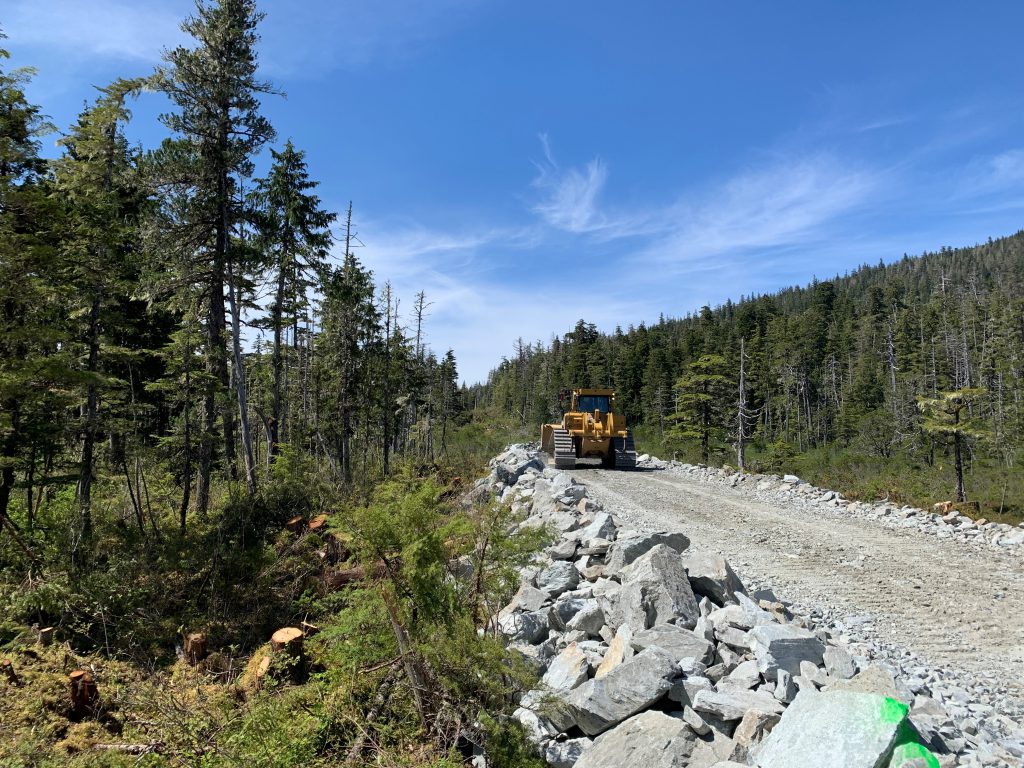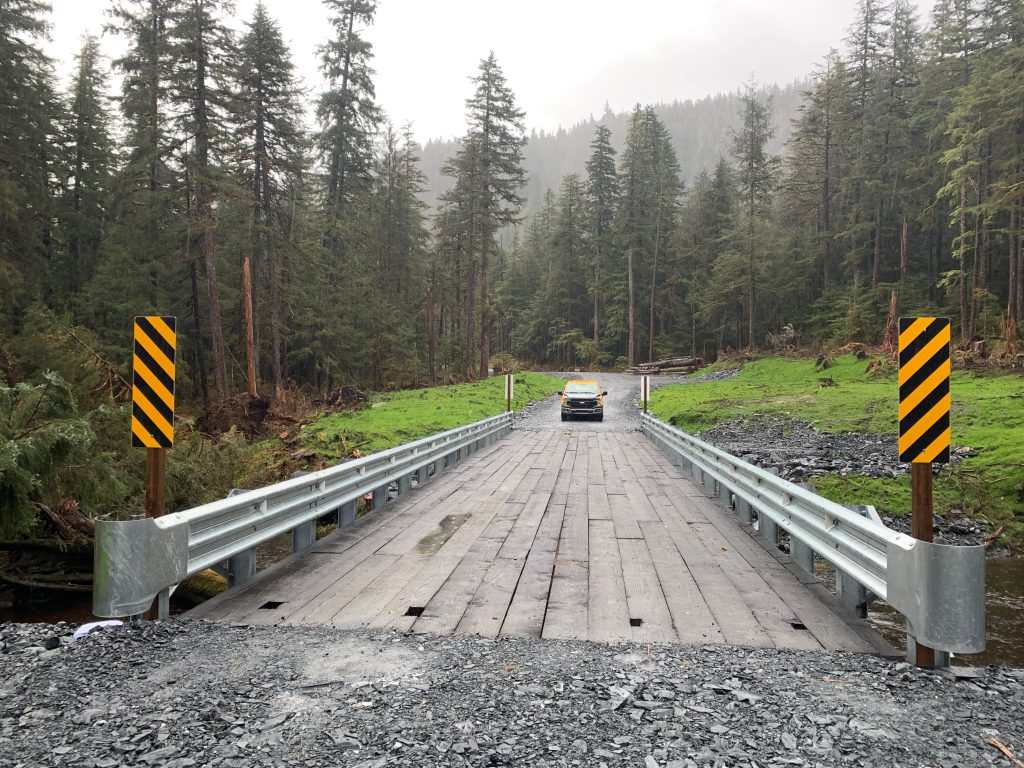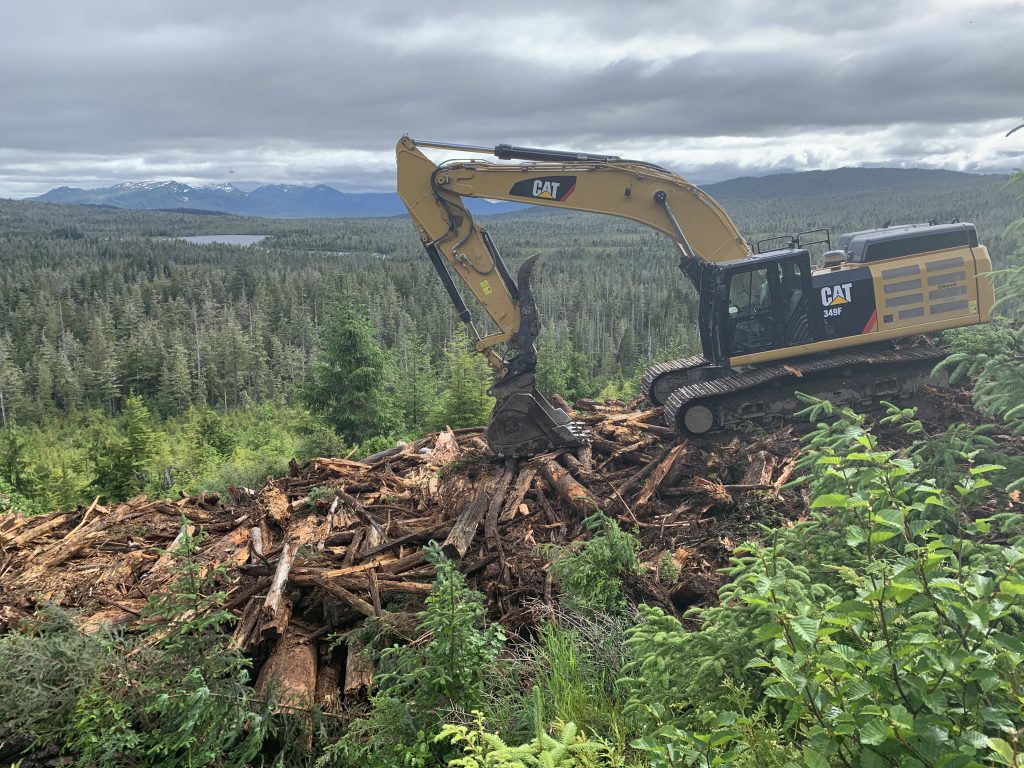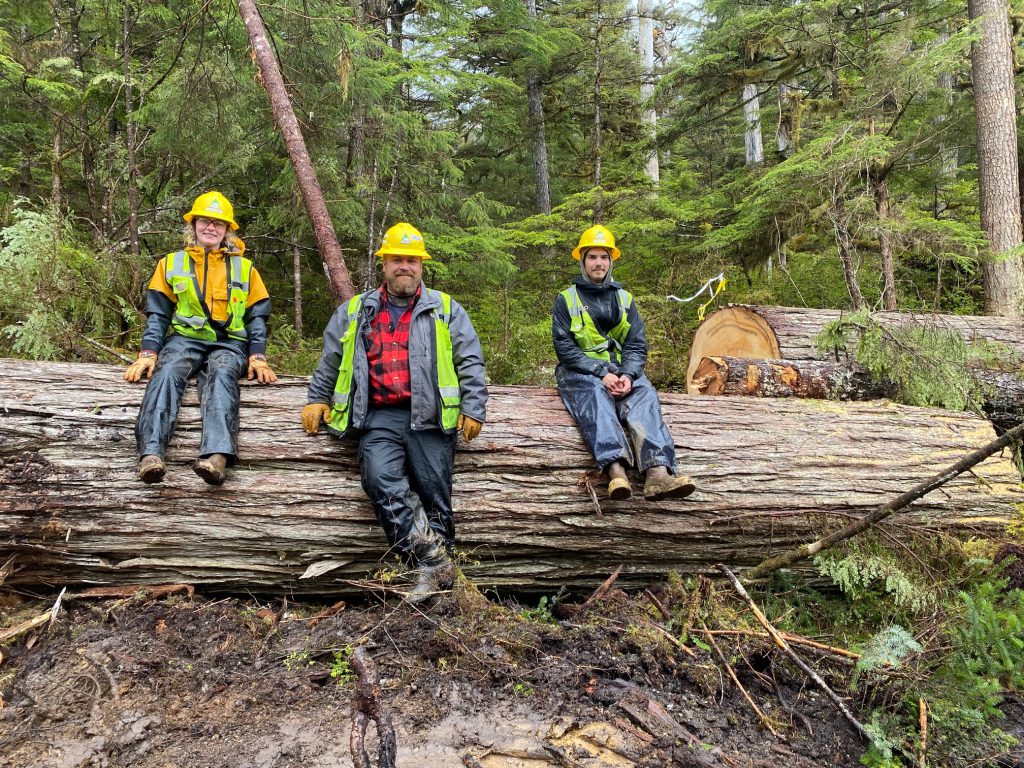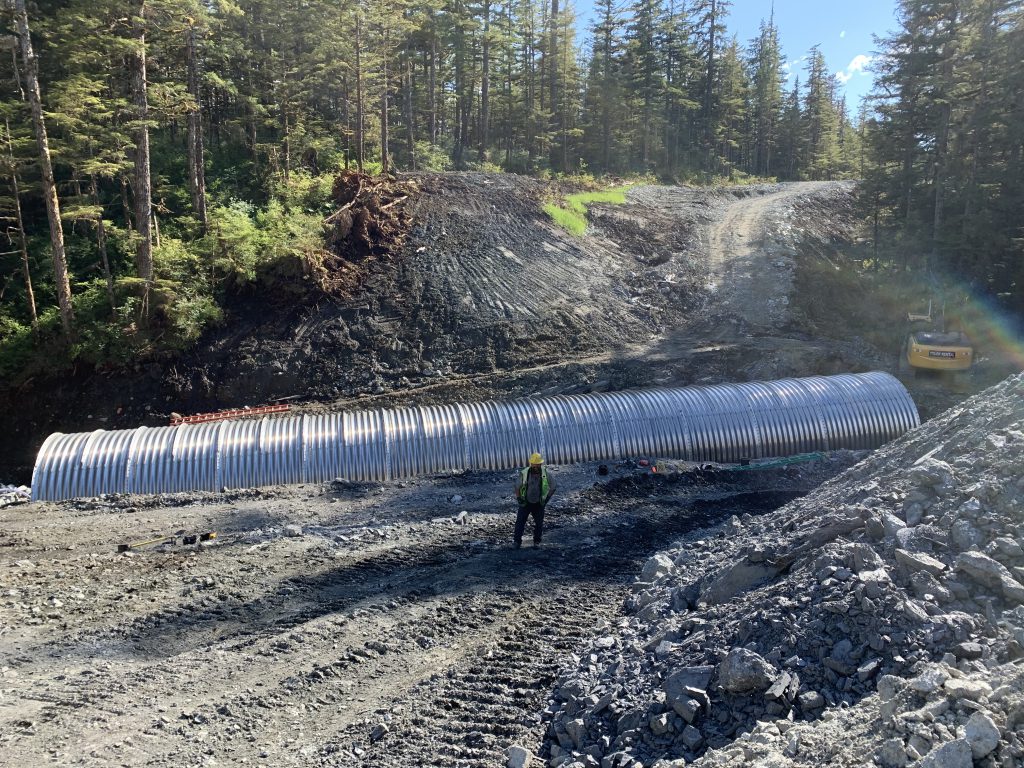If you’re looking for a project that required true out-of-the-box thinking due to remote location, weather limitations, permitting requirements and more, look no further than the Kake Access Road on Kupreanof Island, Alaska.
Kiewit Infrastructure West Co. was recently recognized for its impressive work on the Kake Access Road project, receiving numerous industry awards, including the 2021 Associated General Contractors of Alaska Excellence in Construction, 2021 Excellence in Safety and Top 10 Roads by Roads and Bridges magazine.
When this level of peer-recognition is achieved, it warrants a closer look.
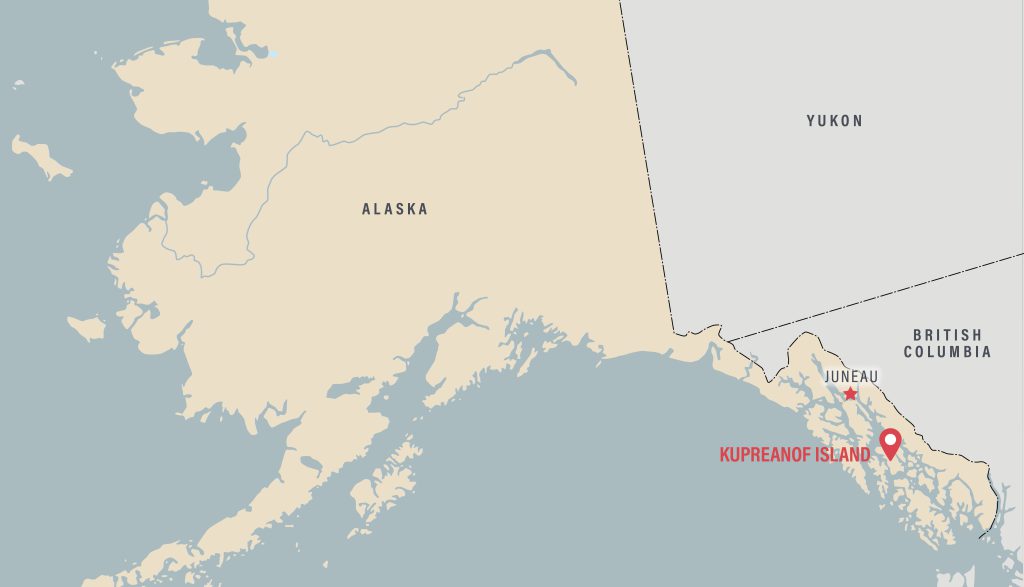
Planning for success
The location of the project set the stage for the complexity of the job. Kake is the largest settlement on the 52-mile by 20-mile island of Kupreanof in southeastern Alaska, with a population of less than 1,000. The goal of the project was to increase access across the island for recreational and subsistence activities and emergency evacuation purposes. The scope included building a road to provide year-round transportation access between Kake and a new boat launch on the eastern shore of the island. This access also increased economic development with another nearby community, Petersburg.
The original plan from the Alaska Department of Transportation and Public Facilities (ADOT&PF) was to construct 14 miles of road and five bridges through the undeveloped Tongass National Forest on the island. This plan was estimated to cost almost $60 million and many logistical difficulties would have needed to be overcome.
Through the Construction Manager/General Contractor (CMGC) contracting method, Kiewit and the project owner were able to collaborate to optimize the original scope and reduce costs significantly, while still achieving the project goals. During preconstruction, Kiewit walked the site with the client to analyze the scope and design, and determined that by using existing roads in the area, they could reduce the need for 7.6 miles of new construction and eliminate four of the originally planned bridges, saving the client $25 million.
Optimizing schedule
The project’s remote location, only accessible by boat or floatplane, made procurement and transportation of materials a complex and challenging endeavor. Further, weather conditions and environmental factors restricted when work could be done.
“When we got out there at the beginning of April, there was still quite a bit of snow on the ground,” Field Engineer and Drill and Blast Supervisor Amanda Lundgren explained. “So, we had to plow the roads and get ourselves set up. We wanted an early start so we could make it in one season.”
Project Manager Clint Lane has more than 30 years of experience building challenging projects on remote islands in Alaska. He said, “The logistics on a job like this is the toughest aspect. Nothing will make or break a job more than logistics.”.
Material management was a crucial component of the project. All equipment and materials had to be delivered to the work site via barge. A comprehensive logistics plan was in place to ensure the camp and project site had the required food, materials and equipment at the right times. Kiewit established close working relationships with local suppliers to obtain fuel, food and materials.
A meticulous procurement schedule was set up to meet the project timeline.
The team was challenged by the presence of large expanses of wetlands and muskeg. A corduroy road made up of a series of logs laid perpendicular to the direction of travel and covered and finished with embankment was determined to be an optimal solution. This eliminated the need to excavate many areas, minimizing impact to surrounding geography.
Taking place simultaneously with construction, Lundgren and the project team engaged in efforts to design blast patterns to produce the materials needed in construction of the road, eliminating the need to bring in additional materials and saving nearly a full construction season of work.
“The team’s resourcefulness and diligence was impressive,” said Lane. “We wound up having exactly the right number of explosives we needed, meaning once arriving on site, we didn’t have to bring additional in and we didn’t have to dispose of any.”
Understanding the seasonal schedule limitations, Lane and the Kiewit team worked closely with ADOT&PF and the project designers to explore alternative materials and concepts to provide cost and schedule savings to
the project.
One advancement included the use of logging equipment specially designed to handle timber up to 8 feet in diameter. Working with a trusted subcontractor to cut and clear trees in advance helped maintain the project’s schedule. This equipment was also reused in other parts of the job, including the placement of a 16-foot structural steel multi plate — a versatile and economic bridge and culvert product.
“In place of using a bridge in one location, we figured out we could use a multi plate,” said Lane. “Because of access issues, we had the multi plate designed in 4-foot segments. Instead of assembling this so that the pipe was laid out linearly on the ground. We stood the pipe on end and put together a 4-foot section at a time and stacked the sections together.”
This innovative thinking allowed the team to assemble the multi plate in increments, cutting installation time in half and improving the safety of operations by eliminating the need for manlifts. This also reduced fall hazards because installation never exceeded shoulder height.
Although serving a small population, a Kiewit team makes a big impact by constructing a year-round access road through a remote Alaskan island.
Although serving a small population, a Kiewit team makes a big impact by constructing a year-round access road through a remote Alaskan island.
Nobody Gets Hurt
In challenging site conditions, safety must be at the forefront of planning. “Our work in Alaska is diverse, requiring project-specific safety plans to address site-specific conditions such as harsh winter weather, remote locations with difficult access, communication challenges, crane safety, traffic control, human/equipment interface and in-water work,” Lane explained.
The team prioritized proper planning and continuous communication to mitigate safety hazards and prevent damage and injury.
Because cell service was limited in the area, the entire Kiewit team was equipped with satellite phones and navigational devices that used GPS and provided texting capabilities. Each team member’s location was monitored, and all devices maintained contact with the Coast Guard and emergency services.
Despite a challenging project location and complex work, the Kiewit team worked 45,554 hours without a recordable incident. Kiewit Infrastructure West Co. was awarded the 2021 Excellence in Safety Award, in part, because of the impressive feats achieved on this project.
Reflecting on the honor of this award, Lane noted, “it is one of the most important awards we can win. We want to attract and retain the best talent — and to be the best talent, you have to share our Nobody Gets Hurt safety philosophy. We want our clients, employees, future employees, partners and future partners to think of safety when they see the name Kiewit.”
Community impact
The impact of this project to the communities on Kupreanof Island cannot be overstated. The access road established an emergency evacuation route and economic development opportunities for all who live on the island.
Despite the challenges of the project site, the team completed the job more than one year ahead of plan. Today, motorists can drive over 40 miles from Kake to a concrete boat ramp with access to navigable waters on Frederick Sound. A true game-changer for the island communities.
Amanda Lundgren (left), Joe Myers (middle) and Daniel Stacey (right) provide perspective to the size of the trees in the area. Some were 8 feet in diameter.
